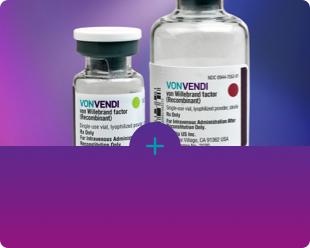
VONVENDI for Pediatric Patients
Indications1
VONVENDI [von Willebrand factor (recombinant)] is indicated in adult and pediatric patients with von Willebrand disease (VWD) for1:
- On-demand treatment and control of bleeding episodes.
- Perioperative management of bleeding.
For adult patients only:
- Routine prophylaxis to reduce the frequency of bleeding episodes.


100% of pediatric patients experienced on-demand treatment success1*
100% of bleeds in pediatric VWD patients received an efficacy rating of “Excellent” (99%) or “Good” (1%) using VONVENDI for on-demand use in clinical trials.
*Treatment success (the primary endpoint) was defined as a mean efficacy rating score of less than 2.5 for all bleeding episodes, assessed on a 4-point rating scale (Excellent=1, Good=2, Moderate=3, None=4) with the investigator comparing the prospectively estimated number of infusions needed to treat the bleeding episode to the actual number of infusions administered.
aNumber of subjects per category (percentage)
A single infusion of VONVENDI resolved the majority of on-demand bleeds in pediatric patients1
PEDIATRIC2
82% of 104 bleeds were cleared up after just 1 infusion (median 1, range 1-9); 94% with 1-2 infusions2
n (%) (n=48)
MODERATE
n (%) (n=31)
n (%) (n=2)
n (%) (n=23)
n(%) (n=104)
1
2
3
>5
37 (84.1%)
6 (13.6%)
1 (2.3%)
0 (0%)
23 (76.7%)
4 (13.3%)
1 (3.3%)
2 (6.7%)
1 (50.0%)
0 (0%)
1 (50.0%)
0 (0%)
19 (86.4%)
2 (9.1%)
1 (4.5%)
0 (0%)
80 (81.6%)
12 (12.2%)
4 (4.1%)
2 (2.0%)

On-demand study description
Hemostatic efficacy of VONVENDI with or without rFVIII for on-demand treatment of non-surgical bleeds was studied in a multicenter, open-label trial in 18 pediatric patients with severe VWD. Patients were followed for ≥12 months. Twenty-eight bleeds in 7 patients were treated with VONVENDI (40–60 IU/kg; median 48, range 18–63) plus rFVIII (30–45 IU/kg; median 33, range 9–45). Seventy-six bleeds in 15 patients were treated with VONVENDI alone (40–60 IU/kg; median 49, range 18–86) when baseline FVIII ≥30%. In eight patients, 18 bleeds required at least one additional VONVENDI dose every 8–24 hours to maintain VWF:RCo and FVlll levels.1
Study safety
Of the 122 TEAEs observed in the trial, 1 TEAE of nausea (moderate in severity) was considered to have a causal relationship to VONVENDI.2
rFVIII=recombinant factor VIII


100% of pediatric VWD patients had their surgical bleeding successfully managed with VONVENDI1†
Successful control of bleeding episodes was assessed in a total of 4 pediatric patients during surgeries such as second stage buccal mucosa hypospadias reconstruction, tunneled central venous catheter with subcutaneous port removal (emergency surgery), and circumcision.1
100% (4 out of 4) of pediatric surgeries treated with VONVENDI were rated "Excellent” for both hemostatic efficacy and blood loss rating.1
†Treatment success was defined as achieving a hemostatic efficacy rating of “Excellent” or “Good.” Excellent: Hemostasis achieved with VONVENDI, with or without recombinant factor VIII (rFVIII), was as good as or better than expected for a hemostatically normal patient undergoing the same type of surgery. Good: Hemostasis achieved with VONVENDI, with or without rFVIII, was probably as good as expected for a hemostatically normal patient undergoing the same type of surgery.1

Surgery (Perioperative) study description
The multicenter, open-label trial evaluated the efficacy of VONVENDI with or without rFVIII in managing surgical bleeding in pediatric patients with severe VWD. Four patients completed the study and underwent 4 minor surgeries, including stage 2 buccal mucosa hypospadias reconstruction, tunneled central venous catheter with subcutaneous port removal (emergency), and circumcision. The mean dose of VONVENDI administered during the 4 surgeries was 94 IU/kg (mean 1.8 preoperative infusions) and 117 IU/kg (mean 2.3 postoperative infusions). One patient received 5 infusions of rFVIII (one preoperative and 4 postoperative infusions) during one surgery.1
Study safety
In the 4 patients who underwent surgery, 2 patients reported 3 TEAEs. One TEAE of presyncope of mild severity was considered related to the study procedure of venipuncture.1,2

For on-demand and surgery, VONVENDI may be dosed with or without rFVIII.1‡
Dosing of VONVENDI*, with or without rFVIII, should be based on patient need as determined by monitoring levels and clinical judgment.
‡VONVENDI contains trace amounts of rFVIII.
VONVENDI: an established safety profile
VONVENDI first received FDA approval for on-demand treatment and control of bleeding episodes in adults in 2015 and has 10 years of real-world use.1
VONVENDI is the first and only recombinant VWF treatment option for VWD. 1,3-5
- Recombinant products are manufactured without blood or human plasma, so there is virtually no risk of blood-borne pathogen transmission.6,7
VONVENDI's safety profile was established in 6 clinical trials1
- Of the 132 total study participants across 6 clinical studies, the following adverse reactions were observed: headache (n=18), vomiting (n=9), nausea (n=7), dizziness (n=4), generalized pruritus (n=3), hypertension (n=2), vertigo (n=2), tachycardia (n=1), infusion site paresthesia (n=1), chest discomfort and increased heart rate (n=1), hot flush (n=1), deep vein thrombosis (n=1), dysgeusia (n=1), tremor (n=1), electrocardiogram T wave inversions (n=1)1
- Across all studies and age groups, no study participants developed anaphylaxis or neutralizing antibodies.2

Although no study participants developed anaphylaxis or neutralizing antibodies across all studies, HCPs should continue to monitor for anaphylaxis and inhibitor development.2
Read Dosing by Indication
Prophylaxis, on-demand, and perioperative dosing for VONVENDI1
Support for Your Patients
Browse a variety of resources from Takeda for your appropriate patients
Contact a Takeda Rep
Get in touch with a Takeda representative in your area
References
- VONVENDI [von Willebrand factor (Recombinant)] Prescribing Information.
- Data on file, Takeda, Inc.
- ALPHANATE [antihemophilic factor/von Willebrand factor complex (human)] Prescribing Information.
- HUMATE-P [Antihemophilic Factor/von Willebrand Factor Complex (Human)] Prescribing Information.
- WILATE [von Willebrand Factor/Coagulation Factor VIII Complex (Human)] Prescribing Information.
- Franchini M, Mannucci PM. Von Willebrand factor (Vonvendi®): the first recombinant product licensed for the treatment of von Willebrand disease. Expert Rev Hematol. 2016;9(9):825-830.
- Turecek PL, Mitterer A, Matthiessen HP, et al. Development of a plasma- and albumin-free recombinant von Willebrand factor. Hamostaseologie. 2009;29 Suppl 1:S32-S38


